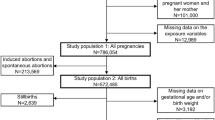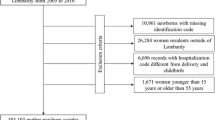Abstract
Objectives
This study aimed to investigate the associations of combined parental low educational level and combined parental unemployment on the risk of preterm birth (PTB) in Korea.
Methods
Data on 427,857 singleton births were obtained from the National Birth Registration (NBR) database in 2003 and analyzed. Parental education and parental employment status were combined as exposure for analysis. Place of birth, sex, marital status, parental age and parity were included for analysis of unconditional multiple logistic regressions. PTB was defined as birth before a gestational age of 37 complete weeks.
Results
Group of the lowest educational level, below high school, had the highest odds of PTB in both father and mother in multivariable analysis [odds ratio (OR) 1.15 and 1.16, respectively]. After combining parental educational status for the multivariable analysis, the highest probability of PTB was in families where both parents had below college level education (OR 1.22). As for paternal employment, the multivariable analysis showed an increased rate of PTB occurred where the father was unemployed (OR 1.11). After combining the employment status of both parents, the multivariable analysis revealed that PTB was only significant in families where both parents were unemployed (OR 1.09).
Conclusions
We found that combined parental low educational level and combined parental unemployment increased the likelihood of preterm birth.

Similar content being viewed by others
References
Andres RL, Day MC (2000) Perinatal complications associated with maternal tobacco use. Semin Neonatol 5(3):231–241. doi:10.1053/siny.2000.0025
Babalola S, Fatusi A (2009) Determinants of use of maternal health services in Nigeria—looking beyond individual and household factors. BMC Pregnancy Childbirth 9:43. doi:1471-2393-9-43
Bloomberg L, Meyers J, Braverman MT (1994) The importance of social interaction: a new perspective on social epidemiology, social risk factors, and health. Health Educ Q 21(4):447–463 (discussion 465–469)
Brett KM, Strogatz DS, Savitz DA (1997) Employment, job strain, and preterm delivery among women in North Carolina. Am J Public Health 87(2):199–204
Bronstein JM et al (2011) Improving perinatal regionalization for preterm deliveries in a medicaid covered population: initial impact of the Arkansas ANGELS intervention. Health Serv Res doi:10.1111/j.1475-6773.2011.01249.x
Chen XK, Wen SW, Krewski D, Fleming N, Yang Q, Walker MC (2008) Paternal age and adverse birth outcomes: teenager or 40+, who is at risk? Hum Reprod 23(6):1290–1296
Cole TJ, Donnet ML, Stanfield JP (1983) Unemployment, birthweight, and growth in the first year. Arch Dis Child 58(9):717–721
Conger RD, Conger KJ, Elder GH Jr, Lorenz FO, Simons RL, Whitbeck LB (1992) A family process model of economic hardship and adjustment of early adolescent boys. Child Dev 63(3):526–541
Daltveit AK et al (1998) Sociodemographic risk factors for sudden infant death syndrome: associations with other risk factors. The Nordic epidemiological SIDS study. Acta Paediatr 87(3):284–290
Demissie K et al (2001) Trends in preterm birth, neonatal mortality among blacks, whites in the United States from 1989 to 1997. Am J Epidemiol 154(4):307–315
Dickute J, Padaiga Z, Grabauskas V, Nadisauskiene RJ, Basys V, Gaizauskiene A (2004) Maternal socio-economic factors and the risk of low birth weight in Lithuania. Medicina (Kaunas) 40(5):475–482
Fikree FF, Berendes HW (1994) Risk factors for term intrauterine growth retardation: a community-based study in Karachi. Bull World Health Organ 72(4):581–587
Goffinet F (2005) Primary predictors of preterm labour. Bjog 112(Suppl 1):38–47
Goldenberg RL, Culhane JF, Iams JD, Romero R (2008) Epidemiology and causes of preterm birth. Lancet 371(9606):75–84
Gould JB, Madan A, Qin C, Chavez G (2003) Perinatal outcomes in two dissimilar immigrant populations in the United States: a dual epidemiologic paradox. Pediatrics 111((6 Pt 1)):e676–e682
Habib NA, Lie RT, Oneko O, Shao J, Bergsjo P, Daltveit AK (2008) Sociodemographic characteristics and perinatal mortality among singletons in North East Tanzania: a registry-based study. J Epidemiol Community Health 62(11):960–965. doi:62/11/960
Hanke W, Saurel-Cubizolles MJ, Sobala W, Kalinka J (2001) Employment status of pregnant women in central Poland and the risk of preterm delivery and small-for-gestational-age infants. Eur J Public Health 11(1):23–28
Heaman MI, Newburn-Cook CV, Green CG, Elliott LJ, Helewa ME (2008) Inadequate prenatal care and its association with adverse pregnancy outcomes: a comparison of indices. BMC Pregnancy Childbirth 8:15. doi:1471-2393-8-15
Jansen P et al (2009) Employment status and the risk of pregnancy complications. The generation R study. Occup Environ Med. doi:oem.2009.046300
Kim MH (2008) Changes in birth rates of low birth weight and premature infants in Korea over the past 7 years. Korean J Pediatr 51(3):233–236
Kim YJ, Lee BE, Park HS, Kang JG, Kim JO, Ha EH (2005) Risk factors for preterm birth in Korea: a multicenter prospective study. Gynecol Obstet Invest 60(4):206–212
Koupilova I et al (1998) Social variation in size at birth and preterm delivery in the Czech Republic and Sweden, 1989–91. Paediatr Perinat Epidemiol 12(1):7–24
Kramer MS, Seguin L, Lydon J, Goulet L (2000) Socio-economic disparities in pregnancy outcome: why do the poor fare so poorly? Paediatr Perinat Epidemiol 14(3):194–210
Kwon S (2003) Payment system reform for health care providers in Korea. Health Policy Plan 18(1):84–92
Kwon S (2009) Thirty years of national health insurance in South Korea: lessons for achieving universal health care coverage. Health Policy Plan 24(1):63–71. doi:czn037
Lamy Filho F, Assuncao Junior AN, Silva AA, Lamy ZC, Barbieri MA, Bettiol H (2007) Social inequality and perinatal health: comparison of three Brazilian cohorts. Braz J Med Biol Res 40(9):1177–1186
Larson EH, Hart LG, Rosenblatt RA (1992) Rural residence and poor birth outcome in Washington state. J Rural Health 8(3):162–170
Lasswell SM, Barfield WD, Rochat RW, Blackmon L (2010) Perinatal regionalization for very low-birth-weight and very preterm infants: a meta-analysis. JAMA 304(9):992–1000. doi:304/9/992
Lee H, Yoon S, Ahn H, Ha M, Koh KS, June KJ (2004) A survey on prenatal environmental risk factors for mothers of low birth weight infants in Asan-City. Korean J Prev Med 37(1):11–16
Lekea-Karanika V, Tzoumaka-Bakoula C, Matsaniotis NS (1999) Sociodemographic determinants of low birthweight in Greece: a population study. Paediatr Perinat Epidemiol 13(1):65–77
Mamelle N, Bertucat I, Munoz F (1989) Pregnant women at work: rest periods to prevent preterm birth? Paediatr Perinat Epidemiol 3(1):19–28
Matevosyan NR (2011) Periodontal disease and perinatal outcomes. Arch Gynecol Obstet 283(4):675–686. doi:10.1007/s00404-010-1774-9
Messer LC, Kaufman JS, Mendola P, Laraia BA (2008) Black-white preterm birth disparity: a marker of inequality. Ann Epidemiol 18(11):851–858
Mozurkewich EL, Luke B, Avni M, Wolf FM (2000) Working conditions and adverse pregnancy outcome: a meta-analysis. Obstet Gynecol 95(4):623–635
National Health Insurance Corporation (2003) Internal reports. Seoul (in Korean)
Nicolaidis C, Ko CW, Saha S, Koepsell TD (2004) Racial discrepancies in the association between paternal vs. maternal educational level and risk of low birthweight in Washington State. BMC Pregnancy Childbirth 4(1):10. doi:10.1186/1471-2393-4-10
Phibbs CS, Bronstein JM, Buxton E, Phibbs RH (1996) The effects of patient volume and level of care at the hospital of birth on neonatal mortality. JAMA 276(13):1054–1059
Phibbs CS, Baker LC, Caughey AB, Danielsen B, Schmitt SK, Phibbs RH (2007) Level and volume of neonatal intensive care and mortality in very-low-birth-weight infants. N Engl J Med 356(21):2165–2175. doi:356/21/2165
Qin C, Gould JB (2006) The Asian birth outcome gap. Paediatr Perinat Epidemiol 20(4):279–289
Rodrigues T, Barros H (2008) Maternal unemployment: an indicator of spontaneous preterm delivery risk. Eur J Epidemiol 23(10):689–693
Saurel-Cubizolles MJ, Gestin G (1991) Housewives, unemployed and employed women: Why different rates of preterm delivery? A French study. Int J Health Sci 2:83–91
Saurel-Cubizolles MJ, Kaminski M (1986) Work in pregnancy: its evolving relationship with perinatal outcome (a review). Soc Sci Med 22(4):431–442
Savitz DA, Terry JW Jr, Dole N, Thorp JM Jr, Siega-Riz AM, Herring AH (2002) Comparison of pregnancy dating by last menstrual period, ultrasound scanning, and their combination. Am J Obstet Gynecol 187(6):1660–1666
Simkhada B, Teijlingen ER, Porter M, Simkhada P (2008) Factors affecting the utilization of antenatal care in developing countries: systematic review of the literature. J Adv Nurs 61(3):244–260. doi:JAN4532
Sweeting H, West P (1995) Family life and health in adolescence: a role for culture in the health inequalities debate? Soc Sci Med 40(2):163–175
Warner B, Musial MJ, Chenier T, Donovan E (2004) The effect of birth hospital type on the outcome of very low birth weight infants. Pediatrics 113((1 Pt 1)):35–41
Wildschut HI, Peters TJ (1991) Determinants of preterm birth in Curacao, Netherlands Antilles. Int J Gynaecol Obstet 36(1):23–27
Yang J, Carmichael SL, Canfield M, Song J, Shaw GM (2008) Socioeconomic status in relation to selected birth defects in a large multicentered US case-control study. Am J Epidemiol 167(2):145–154. doi:kwm283
Author information
Authors and Affiliations
Corresponding author
Rights and permissions
About this article
Cite this article
Shin, S.H., Lim, Ht., Park, Hy. et al. The associations of parental under-education and unemployment on the risk of preterm birth: 2003 Korean National Birth Registration database. Int J Public Health 57, 253–260 (2012). https://doi.org/10.1007/s00038-011-0318-9
Received:
Revised:
Accepted:
Published:
Issue Date:
DOI: https://doi.org/10.1007/s00038-011-0318-9




